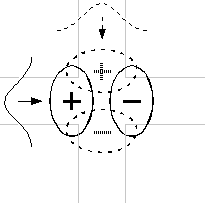
|
|
|
|
|
|
|
|
|
|
|
|
Perfect Waveguide Intersections
In constructing integrated optical "circuits," space constraints and the desire for complex systems involving multiple waveguides necessitate waveguide crossings. We propose a novel method for intersecting waveguides with negligible crosstalk. Moreover, this technique depends on general symmetry considerations that can be applied to almost any system a priori, with little need for manual "tuning."The basic idea is to consider coupling of the four branches, or "ports" of the intersection in terms of coupling through a resonant cavity at the center. If the resonant cavity can be prevented by symmetry from decaying into the crossing waveguide, then the situation reduces to one-dimensional resonant tunnelling, and crosstalk will be prohibited. This situation is achieved by requiring simple symmetries in the waveguide and resonant modes, as shown below:

Here, the solid-line waveguide modes only couple with the solid-line resonant cavity modes, and similarly for the dashed-line modes. Essentially, there are three requirements that must be met:
- The waveguides must have mirror symmetry about their axis, and they must be single-mode in the frequency range of interest. (This mode will be either even or odd.)
- The resonant cavity in the center of the intersection, which governs coupling between the waveguides, must respect the mirror planes of both waveguides.
- In the frequency range of interest, the resonant modes must be odd with respect to one waveguide and even with respect to the other.
For a demonstration of how this works, we have put together a couple of animations (in QuickTime format) showing waveguide intersections in operation. These animations are for two-dimensional systems, but the same principle works in three dimensions.
First, let us examine an intersection of two waveguides in a photonic crystal consisting of a square lattice of dielectric rods in air. Photonic crystals are an ideal way to make such a crossing because they prevent the possibility of any radiation loss. It is also easy to make a resonant cavity of any desired frequency and symmetry simply by tuning the radius of a single defect rod.
If we simply cross two waveguides (formed by removing a row or column of rods), there is significant crosstalk, as shown below. (Both transmission and crosstalk are in the 30-40% range.) The animation depicts the z-component of the electric field for an incident TM wave from the left; positive and negative values are indicated by blue and red. The contours of the dielectric are shown in black. Note that there is significant reflection from the intersection.